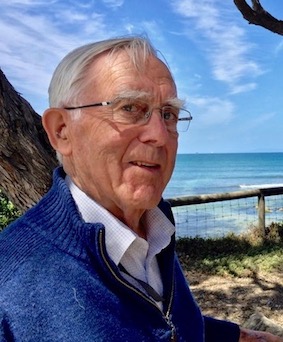 (02.09.1931- 09.11.2017)
(02.09.1931- 09.11.2017)
ACADEMIC QUALIFICATIONS
MBBS, FRCS, FRACS
EARLY DAYS AND TRAINING
Julian Keogh was born in Melbourne and completed his secondary schooling at Xavier College, Kew. He studied medicine at Melbourne University and graduated from the clinical school of St Vincent’s Hospital in 1956. He spent 1957 and 1958 in residence at St Vincent’s before going to England to complete his paediatric surgical training. He travelled to England as the ship’s Doctor on a P&O cargo ship called the “Bendigo”, such was his spirit of adventure. Julian worked as a Surgical Registrar at Queen Mary’s Hospital, London in 1962 and obtained the FRCS England that same year. From March 1963 – September 1964 he worked as a Senior House Officer and Surgical Registrar at Alder Hey Children’s Hospital, Liverpool. During his time in Liverpool, Julian married fellow doctor, Marguerita Regan.
RETURN TO AUSTRALIA
Upon his return to Melbourne in 1963, Julian continued his paediatric surgical training and was awarded the FRACS in paediatric surgery. Although practicing general paediatric surgery at St Vincent’s Hospital (1964 -1988) and the Austin Hospital, his principal surgical interest lay in the management of burns. He was appointed surgeon to the Burns Unit as the Royal Children’s Hospital in February 1967 where he worked for more than 30 years before his retirement in1998. His main work was devoted to the care of children with burns. In the more severe cases, a normal child is changed in a few seconds into one who can be permanently disfigured. Julian was familiar with many of the problems faced by these children. He recalled one girl whose feet were so burnt that she could not tolerate walking on nylon carpet or wearing nylon socks because of the prickling sensation they caused. His devotion to the care of these patients led to his being awarded a Royal Children’s Hospital President’s Medal in 1998.
Julian was very patient, gentle, humble and compassionate - qualities which made him ideally suited to the field in which he worked.
ACCIDENT PREVENTION
Julian recognised the great importance of prevention of accidents, both burns and general accidents. He was instrumental in being a foundation member of the Australian and New Zealand Burn Association (ANZBA) in 1975 (President 1992-1993). Along with his colleagues Murray Clarke and John Soloman, he initiated a range of burn prevention research and development endeavours. One such activity involved collaboration with the CSIRO protein chemistry research department to test the flammability of children's nightwear. It led to an Australian Standard that required flammability warning labels to be sewn into children’s clothing, a standard that was adopted world-wide.
Julian was also involved in the establishment of the Child Accident Prevention Foundation of Australia in 1979 (now KidSafe), which advocated means around the home such as preventing spillage from kitchen benches and stoves, reducing the temperature of hot water tanks, banning fireworks sales, and working with the Australian Airlines Association to adopt safer methods of pouring tea and coffee whilst in flight.The success of this activity was shown by a 50% decline in the incidence of childhood burns.
As a Fellow of the Royal Australasian College of Surgeons, Julian was a member of the College Road Trauma Committee for many years, which successfully lobbied for compulsory seat belts in both cars and long distance buses.
FURTHER INTERESTS
Julian spent childhood holidays at Wilson’s Promontory and this was a place that he was always very attached to. Throughout his life, up until a year ago before he passed away, he went on holidays with family to the Prom to go bushwalking and take in its natural beauty. This love of the Australian native plants saw him complete a Diploma of Horticulture at Burnley after his retirement.
Outside the hospital Julian was a very practical man. He took on a large project of building a mudbrick house at Yea, for which he learned not only how to make mudbricks but also how to construct an entire house (!), and this was a venture that carried on from the mid 1970’s until well into to 2000’s with many family, friends and colleagues all sharing his enjoyment. Hecould advise on where to find all sorts of bits and pieces used in building projects. He hated to see waste so disposable items which he could use, such as wire from diathermy plates, was used to tie up growing beans!
Julian is survived by his second wife Brenda, and four of his five children, as well as five grandchildren.